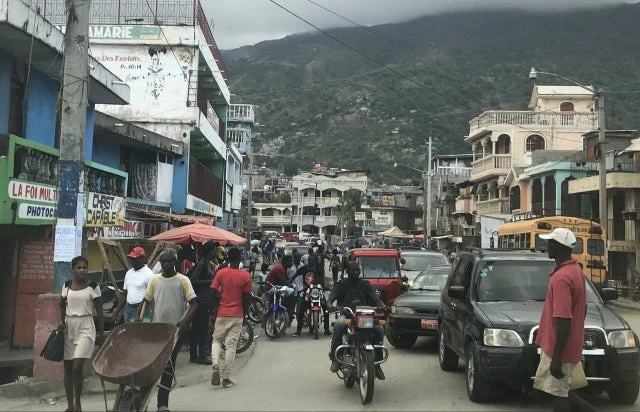Landing in Port-au-Prince awakens your senses. Exiting the airplane, you are re-energized by the explosion of colors, the welcoming smiles, and the warm weather – particularly when coming from a cold January in Washington, D.C. Loud honking, a high density of houses and buildings, and streets bustling with pedestrians and small informal businesses are all evidence of the rapid urbanization process in Haiti.
As soon as you land, the challenges of the city are evident; Port-au-Prince expands to the ocean on flat plains exposed to flooding and quickly rises on steep hills with challenging access and risks of landslides and flash floods. The reconstruction efforts after the earthquake in 2010 are still ongoing, and many of the houses seem to be hanging from the sky, perched on steep slopes. If you look at the houses from afar they appear as a single skyscraper, as distance makes the houses seem as if they are built on top of the one another. These false skyscrapers are highly exposed to landslides, flooding and earthquakes.
[Read: Five Reasons Why Haiti Should Invest in Resilient Cities]
“Haitian Cities: Actions for Today with an Eye on Tomorrow” – launched in January 2018 in Port-au-Prince and Cap Haitien, the second largest city in Haiti, provides evidence of the challenges of urbanization in Haiti and puts forward actions for changes along three lines:
- Move toward resilient urban planning to address current infrastructure deficits and prepare for future urban growth. This includes bridging basic service deficits, leveraging information for decision making, and strengthening property rights. Haiti is urbanizing at a very fast pace, averaging 5 percent annually, and access to infrastructure services is simply unable to keep up. Today one-third of city residents in Haiti lack access to potable water, and two-thirds lack access to improved sanitation.
- Enhance city connectivity and accessibility through improved transport and coordination between land use and transport investments. Investing in and improving efficiency of collective transport operations, increasing affordability, better managing public space and linking planning and transport investments. Seventy-five percent of Port-au-Prince residents who walk to work every day, are cut off from the local labor market. They have difficulty accessing 18 percent of the jobs that are within an hour commute.
- Strengthen the role of local authorities while improving municipal finances. Consolidate, harmonize and enforce existing legal and regulatory frameworks; build capacity and expand public financial management by addressing existing gaps in the flow of resources from central to municipal and local governments; and leverage local revenue potentials. Except for Port-au-Prince and Cap Haitien municipalities in Haiti rely heavily on central government transfers for 90 percent of their resources, often delayed, severely impacting their ability to deliver services.
[Download: Investing in Urban Resilience: Protecting and Promoting Development in a Changing World ]
In the past decade, Haiti has experienced natural hazards, including the devastating 2010 earthquake that claimed some 220,000 lives and cost 120 percent of GDP in damages and losses; and hurricanes, including the 2016 hurricane Matthew which affected over two million people and inflicted damages equivalent to 29 percent of GDP.
Still, there is a growing urgency for all stakeholders to work together and build Haiti’s long-term resilience to disasters and at the same time create jobs and improve service delivery. As the proverb goes in Creole “Nou Se Wozo, Pliye Nou Se Pa Kase”, which translates as “We are like a reed, we bend but we don’t break!”
Related links:
- Subscribe to our Sustainable Communities newsletter and Flipboard magazine
- Follow @BancoMundialLAC and @WBG_Cities on Twitter
- Read Haitian Cities: Actions for Today with an Eye on Tomorrow report by Nancy Lozano Garcia and Marisa Garcia Lozano, with support from the Global Facility for Disaster Reduction and Recovery (GFDRR), World Bank’s Jobs Umbrella Trust Fund, the Innovations in Big Data Analytics program, as well as technical support from Digicel and Flowminder






Join the Conversation